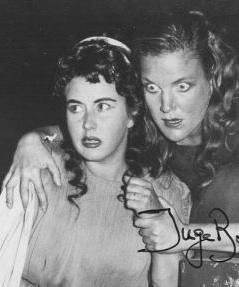One idea that tends to still the bickering among opera queens (who like nothing more than a good bicker), because it's just so obviously correct, is that venues are needed in the city for operas that lose something in a 4,000 seat house. Venues and companies, really. Because the You-Know-Who can dance on its toes like a cartoon elephant and put on Mozart and Handel, but it's not what they do best, and anyway the hall has a way of ironing out the subtleties. Performances that would work at Glimmerglass would look like not much of anything in the Barn, so the singers have to embiggen everything*. Here and there we have the singer like Roschmann with the right style for Mozart or Handel, the right grain in her voice to put the heartbreak over and be heard, but it's no fun waiting around for things like that.
It's probably just a financial reality of the city and an aesthetic reality of the century that appropriate forces and spaces for, say, Monteverdi...
Did somebody say Monteverdi?! As you may have read in the Times, but it bears repeating, a company called Opera Omnia has taken it into their heads to put on an English language Poppea at a "multimedia art cabaret" called Le Poisson Rouge, whose website proclaims: Serving Art and Alcohol. And who's going to argue with that? “Eh bien! que l’atmosphère est bizarre!” as the boys are saying, but this does seem to solve the problem of un-intimate performance spaces--as I'm guessing they don't seat 4,000--and another one, besides.
Now, I have mixed feelings about the idea of stuffiness in opera venues. I'm as pro-stuffy as the next so-and-so when I'm at a de facto stuffy institution of art delivery and someone the row behind me thinks the whole unspoken "no talking" thing is a milennial relic. But it's all about expectations...you go to that "Opera on Tap" thing for instance, if that's still up and running, and you know what you're getting into. Here, I assume, in a space called a cabaret, things will be on the loose side as well. And I think Monteverdi might be a good match for that kind of thing, both because--if my history is correct--this is opera from long before concert-going became so formal anyway, and because yes, Poppea has its chatty patches, let us admit, that could be smoothed over admirably by a sazerac or whatever the kids are ironically swilling, and the possibility of not sitting abso-bloomin-lutely still. (I think it is fair to expect that it will be a laid back, almost outdoorsy vibe, considering the line on Le Poisson Rouge's website that says "the venue's mission is to revive the symbiotic relationship between art and revelry" and if that doesn't clinch it, "bring open mind and drinking shoes" does. It's a little hipstery, but ok.)
The whole thing has more the feel of young musicians trying to do a little revitalizing from within, guided by their own aesthetics, than (with all apologies to Mr. Gelb et al who are doing, if you ask me, a bang-up job in most ways) battle-worn pros trying to figure out how to market kids into the concert hall, and this makes it promising.
So hey, theorbos and ethanol! I'm going--are you?
*Cromulence included
Monday, August 18, 2008
Subscribe to:
Post Comments (Atom)

2 comments:
Audiences went to theater and opera in a very casual way, eating dinner in the boxes, wandering around the house to greet friends, talking at will, etc. etc. until the latter quarter of the 19th century.
In opera, Wagner led the reform movement with the way his operas were performed at Bayreuth. In spoken theater, one of the great leaders was playwright August Strindberg who blithely appropriated all of Wagner's reforms and published them as his own in the famous Preface to his play Miss Julie a dozen years after the opening of Bayreuth with the Ring in 1876.
I've seen signs of the Wagnerian discipline softening for years in our theaters: everything from bringing babies to the theater; through the whole cell phone thing including taking and making calls in the MET; to bringing food into the auditorium--in several cases I've personally experienced, with the permission and even encouragement of the theater management. We won't even speak of the frequent/constant talking during performances.
Ironically, the authentic performance practice specialists may soon see the ultimate in authentic performances, where the 18th century singing and playing style is viewed by a mobile, talking, eating and drinking audience. One wonders if they'll welcome the noise!
I've been to Le Poisson Rouge for one nominally "classical" concert, and the audience was noticeably into it and relatively well behaved (it was a miked and loud remix of Stravinksy's Rite of Spring; no idea what people would do with Monteverdi). I think the space does feel both like a nightspot and a performance space, so some attention and reasonably civil behavior from the audience might be expected.
I do like the space a lot, as I do the idea of having a few taps to go with my opera, Monteverdi or not.
Post a Comment